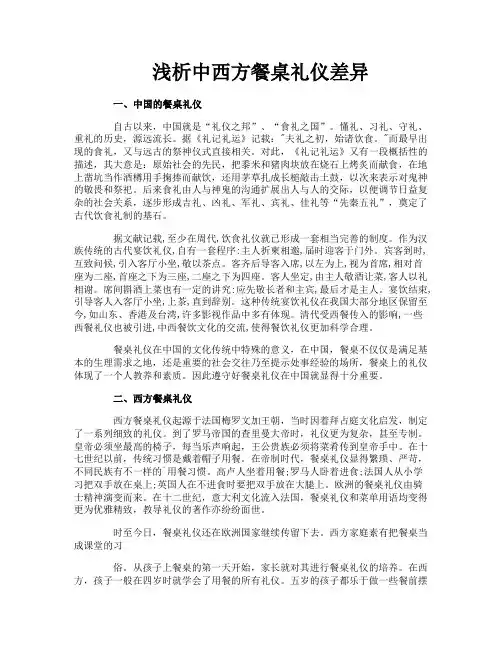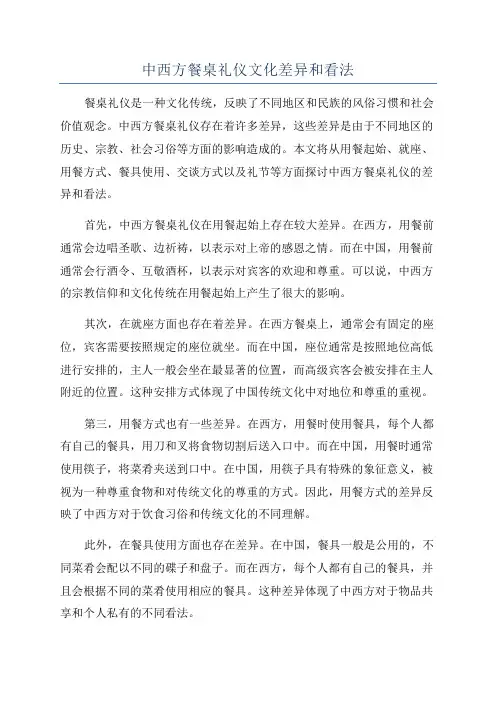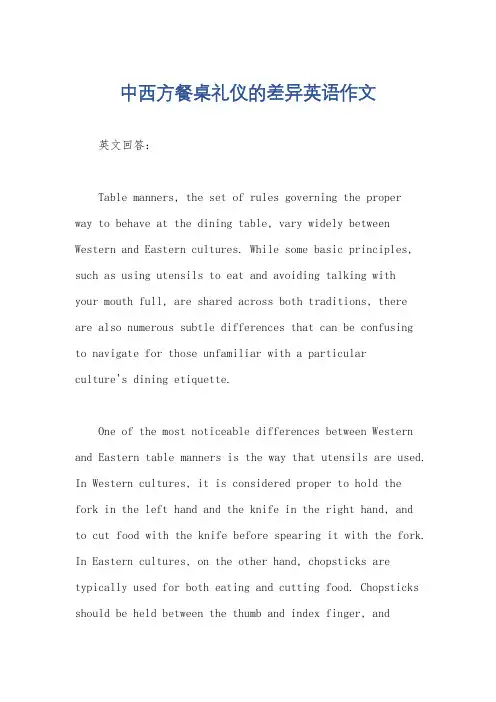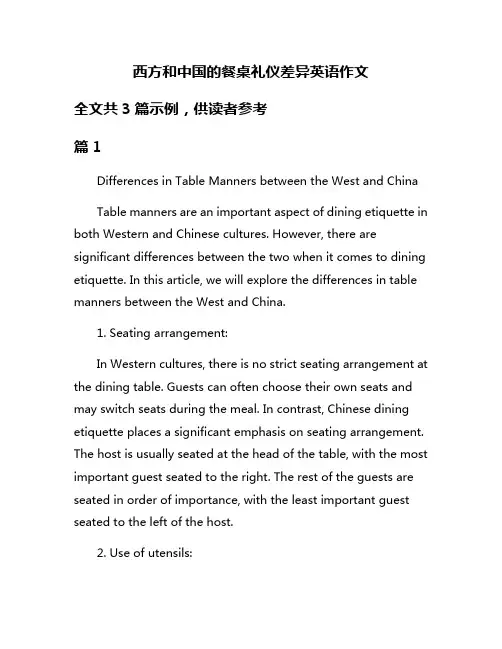中西方餐桌礼仪差异
浅析中西方餐桌礼仪差异

浅析中西方餐桌礼仪差异一、中国的餐桌礼仪自古以来,中国就是“礼仪之邦”、“食礼之国”。
懂礼、习礼、守礼、重礼的历史,源远流长。
据《礼记礼运》记载:"夫礼之初,始诸饮食。
"而最早出现的食礼,又与远古的祭神仪式直接相关。
对此,《礼记礼运》又有一段概括性的描述,其大意是:原始社会的先民,把黍米和猪肉块放在烧石上烤炙而献食,在地上凿坑当作酒樽用手掬捧而献饮,还用茅草扎成长槌敲击土鼓,以次来表示对鬼神的敬畏和祭祀。
后来食礼由人与神鬼的沟通扩展出人与人的交际,以便调节日益复杂的社会关系,逐步形成吉礼、凶礼、军礼、宾礼、佳礼等“先秦五礼”,奠定了古代饮食礼制的基石。
据文献记载,至少在周代,饮食礼仪就已形成一套相当完善的制度。
作为汉族传统的古代宴饮礼仪,自有一套程序:主人折柬相邀,届时迎客于门外。
宾客到时,互致问候,引入客厅小坐,敬以茶点。
客齐后导客入席,以左为上,视为首席,相对首座为二座,首座之下为三座,二座之下为四座。
客人坐定,由主人敬酒让菜,客人以礼相谢。
席间斟酒上菜也有一定的讲究:应先敬长者和主宾,最后才是主人。
宴饮结束,引导客人入客厅小坐,上茶,直到辞别。
这种传统宴饮礼仪在我国大部分地区保留至今,如山东、香港及台湾,许多影视作品中多有体现。
清代受西餐传入的影响,一些西餐礼仪也被引进,中西餐饮文化的交流,使得餐饮礼仪更加科学合理。
餐桌礼仪在中国的文化传统中特殊的意义,在中国,餐桌不仅仅是满足基本的生理需求之地,还是重要的社会交往乃至提示处事经验的场所,餐桌上的礼仪体现了一个人教养和素质。
因此遵守好餐桌礼仪在中国就显得十分重要。
二、西方餐桌礼仪西方餐桌礼仪起源于法国梅罗文加王朝,当时因着拜占庭文化启发,制定了一系列细致的礼仪。
到了罗马帝国的查里曼大帝时,礼仪更为复杂,甚至专制。
皇帝必须坐最高的椅子,每当乐声响起,王公贵族必须将菜肴传到皇帝手中。
在十七世纪以前,传统习惯是戴着帽子用餐。
在帝制时代,餐桌礼仪显得繁琐、严苛,不同民族有不一样的`用餐习惯。
中西方餐桌礼仪差异[大全五篇]
![中西方餐桌礼仪差异[大全五篇]](https://uimg.taocdn.com/c9dae5195627a5e9856a561252d380eb629423ec.webp)
中西方餐桌礼仪差异[大全五篇]第一篇:中西方餐桌礼仪差异中国是一个有着5000年文化历史的文明古国,一直有着其自己的餐桌礼仪。
但随着改革开放的深入和加入世贸以后,跨国交际日益增多,中国就不能只注重自己的餐桌礼仪了,因为我们将面对来自世界各地的人。
这些人来自陌生的文化和国家,他们的生活习惯,思维方式,行为方式与我们存在较大差异,以在交往过程中不可避免的会出现文化冲突的现象。
而现在,跨文化交际已经成为人们生活中不可或缺的内容,饮食文化及餐桌礼仪也是跨文化交际中非语言文化的重要组成部分。
我选这个题目的原因就是希望更多的了解再快文化交际中的餐桌礼仪,从而提高跨文化交际的成功率,避免因为不恰当的方式或行为造成误解和交际障碍。
With China's opening to the outside world gradually, western culture more and more into our life.Because what we face is unfamiliar cultures and countries, mode of thinking, life habits and behavior way and we be totally different people, in the process of interaction with the inevitable cultural conflict phenomenon seriously affected the smooth communications.T able manners in communication has occupied an important position, learning and applying proper table manners, has not only its own image, more is to improve benefit, need to improve competitiveness.With the deepening of the international communication, from different countries and cultural backgrounds of people carried out exchanges, the exchange is called intercultural communication.Cross-cultural communication has become an indispensable content.As a result of the area difference, the different nationality, the country formed a different culture.People from different cultural backgrounds communicate information transmission effect,effect of these languages and the non-language factors in intercultural communication cultural communication.If we do not understand, there will be an inappropriate behavior, resulting in communication barriers, it is very difficult to carry out effective cross-cultural communication, so that communication errors.In the Chinese saying goes,“ food is not made, do not sleep”, he explained the Chinese traditional culture on table manners in terms of the interpretation of the phenomenon, while in western culture if people in the meal with neighbour conversation, have lost.Here we will analysis Chinese and western table manners and speech acts in the similarities and differences, because it is to understand the differences between Chinese culture and Western culture is very helpful.The previously mentioned saying “ eat not the words, do not sleep” is not a ban.Whether ancient or modern, formal or informal dinner, people will not be silent, at least to some toast, blessing ceremony, it is just to remind everyone on this occasion speak as little as possible, not only to speech, and don't slip of the tongue, the best course is to speak less, because“ he that talks much errs much”.This also reflects the ancient Chinese Confucianism, Confucius once said,“ don't speak to, speak to the purpose”.Means not say that did not say, that would hit the mark, it is also very serious talk art.On the other hand,“ food is not made” it embodies the scientific diet principle, more in line with the modern social principle.As a member of our ancient oriental country, should all be on your own country's table manners about one or two, only in this way can we be worthy of thousands of years of history and civilization, not only expose oneself to ridicule.Chinese table manners and the problem that should noteTable manners in Chinese life and order in the full possessionof a very important position, eating is not only way to meet their basic physiological needs method, but also is the most important social experience.The round table is popular in China, not only can sit more people, and we can sit face to face, the head of the family 's identity and unlike western long table clearly through his seat and identification.Guests should be invited to sit down and wait for the host, the owner must be careful not to let the guests sitting in a seat near the serving, this is a taboo.Will have to wait until all the people here can only be the beginning of any form of dining, even if they have to wait for being late.Once you place, owner will do the prologue.During the meal, the owner must assume a proactive role, urging guests enjoy eating and drinking.In the eyes of Westerners, Chinese table looks quite empty, before each seat visible one on disc bowl, right is a set of chopsticks and spoons, were placed in their own seat.Chopsticks are eating a tool, so do not play with, regard them as drumstick is a very rude behavior, but can not use chopsticks pointing to the person or motioned.Of course, absolutely can not suck or to chopsticks chopsticks inserted in rice, it is taboo.This is like the funeral of incense, is considered unlucky.Can not use chopsticks in a non-stop flipping Diecai years, should be certain to get food.Take food, try to avoid the encounter other food.If possible, use chopsticks.The mouth of food, should be avoided.Don't gulp plug food, food is ingested, can't plug entrance.Can not be reached across, long extract.When eating, do not produce large noise, will lead to others.Western dining etiquette and the problem that should noteWesterners eat with forks when eating, main, plate in the middle, knife and spoon to the right of the plate, the fork on theleft.When drinking, right hand with a knife or fork, spoon, cup with the right hand end.The knife and fork with different specifications, in accordance with the use of the different size.Speak or talk, should be the knife and fork on the plate.Do not take a knife and fork to dance with joy about, nor speak forks standing up in his hands, never extravagant laughter or loud noises, this will make people feel tremble with fear in one's boots.The knife can not be placed above the entrance, regardless of whether food.Wine dinner, is an indispensable beverage.In China, between subject and object will not stop to drink a toast and a cup of wine, drink, we say “cheers”.In the west, toast, just a little drink, do not drink.Eating not munching, you also don't sound the same, and Chinese etiquette.If continue to Western guests with the food, he may feel uncomfortable.Coffee spoon is used to stir, not to drink, nor in the cup.After the meal, deal with guest host thanks, thanks to his arrival.Western dinner table culture differencesChinese dinner, put it on the desk of the cauliflower like variety, at least seven or eight dishes, if the feast, will be more, more expensive, it demonstrates their enthusiasm and guest.And a host would say“ no good food hospitality of the people”,“ the food is not good, eat a little”,“ forgive me”“ neglect your words like”.While western feast in general to five dish, component to finish or slightly surplus is the best.At home, it is best to finish all the food, so the hostess will happy, think people like her cooking.In the face of a feast, the host will say“ have all to entertain you”.Therefore, Chinese like“ self denigration”, whi le the Westerners emphasize efficiency and pragmatism values, in communication is very focused on their own face need.But the Westerners do not at the banquet on turnone's stomach thing, will make every attempt by implicitly gentle words to replace“ toilet”, such as“ Where can I: wash my hand?”,“ I wonder if I could go somewhere”,“ Can I add some powder?”.In addition, in western countries don't ask“ for dinner?” China's habit of greeting.“ You eat?” Tends to be rather baffling, there may even be a misunderstanding.As in the UK, if you ask people do not eat, the implication is you are interested please each other to eat;for unmarried men and women, indicates that you are interested in dating each other.Chinese and Western diet in the concept, content, etiquette and other aspects of the differences in culture, can be found on the root.Of course, the Western diet culture difference is relative.Under the situation of globalization of intercultural communication, the diversity of food culture to increase the complementarity and compatibility.As the East-West cultural exchanges, the Chinese diet culture in and world culture collision will appear new characteristic, new changes.It is hand contributes more to the Chinese diet culture in exchange, the collision of Bocaizhongzhang, and constantly improve the development, has always maintained a strong vitality;on the other hand will promote the Chinese food culture in the worldwide spread and development.ReferenceHu Wenzhong,“ Intercultural Communication Studies”, Beijing: foreign language teaching and Research Press, 1999 Bi Jiwan,“ Intercultural Nonverbal Communication”, Beijing: foreign language teaching and Research Press, 1999Hu Wenzhong, the English custom of“ comparison”, foreign language teaching and Research Press, 1999Bian Haoyu,“ on the differences between Chinese and Western food culture”, Journal of Nanjing Forestry University,2004第二篇:浅析中西方餐桌礼仪差异浅析中西方餐桌礼仪差异海外教育学院 121280028 郑徐娇摘要:餐桌礼仪是饮食文化的一个重要组成部分。
中西方餐桌礼仪文化差异和看法

中西方餐桌礼仪文化差异和看法餐桌礼仪是一种文化传统,反映了不同地区和民族的风俗习惯和社会价值观念。
中西方餐桌礼仪存在着许多差异,这些差异是由于不同地区的历史、宗教、社会习俗等方面的影响造成的。
本文将从用餐起始、就座、用餐方式、餐具使用、交谈方式以及礼节等方面探讨中西方餐桌礼仪的差异和看法。
首先,中西方餐桌礼仪在用餐起始上存在较大差异。
在西方,用餐前通常会边唱圣歌、边祈祷,以表示对上帝的感恩之情。
而在中国,用餐前通常会行酒令、互敬酒杯,以表示对宾客的欢迎和尊重。
可以说,中西方的宗教信仰和文化传统在用餐起始上产生了很大的影响。
其次,在就座方面也存在着差异。
在西方餐桌上,通常会有固定的座位,宾客需要按照规定的座位就坐。
而在中国,座位通常是按照地位高低进行安排的,主人一般会坐在最显著的位置,而高级宾客会被安排在主人附近的位置。
这种安排方式体现了中国传统文化中对地位和尊重的重视。
第三,用餐方式也有一些差异。
在西方,用餐时使用餐具,每个人都有自己的餐具,用刀和叉将食物切割后送入口中。
而在中国,用餐时通常使用筷子,将菜肴夹送到口中。
在中国,用筷子具有特殊的象征意义,被视为一种尊重食物和对传统文化的尊重的方式。
因此,用餐方式的差异反映了中西方对于饮食习俗和传统文化的不同理解。
此外,在餐具使用方面也存在差异。
在中国,餐具一般是公用的,不同菜肴会配以不同的碟子和盘子。
而在西方,每个人都有自己的餐具,并且会根据不同的菜肴使用相应的餐具。
这种差异体现了中西方对于物品共享和个人私有的不同看法。
另外,交谈方式也是中西方餐桌礼仪差异的一部分。
在西方,用餐时可以随意交谈,没有特别规定的主题或者禁忌。
而在中国,用餐时的谈话通常是有组织和有限制的,一般是由主人带领话题。
这种差异反映了中西方对于社交礼仪和对他人的敬重方式的不同理解。
最后,餐桌礼仪中的礼节也存在差异。
在西方,使用餐巾是非常重要的一部分,用餐前和用餐后都需要擦拭口和手。
中西方餐桌礼仪的差异英语作文

中西方餐桌礼仪的差异英语作文英文回答:Table manners, the set of rules governing the properway to behave at the dining table, vary widely between Western and Eastern cultures. While some basic principles, such as using utensils to eat and avoiding talking withyour mouth full, are shared across both traditions, there are also numerous subtle differences that can be confusingto navigate for those unfamiliar with a particularculture's dining etiquette.One of the most noticeable differences between Western and Eastern table manners is the way that utensils are used. In Western cultures, it is considered proper to hold thefork in the left hand and the knife in the right hand, andto cut food with the knife before spearing it with the fork. In Eastern cultures, on the other hand, chopsticks are typically used for both eating and cutting food. Chopsticks should be held between the thumb and index finger, andshould not be crossed over each other.Another difference between Western and Eastern table manners is the way that rice is eaten. In Western cultures, it is considered acceptable to use a fork to eat rice, while in Eastern cultures, rice is typically eaten with chopsticks. When eating rice with chopsticks, it is important to hold the bowl close to your mouth and to scoop the rice into your mouth with the chopsticks.There are also differences between Western and Eastern table manners with regard to the way that food is shared. In Western cultures, it is considered acceptable to share food by passing dishes around the table. In Eastern cultures, on the other hand, it is considered more polite to serve individual portions of food to each guest.Finally, there are differences between Western and Eastern table manners with regard to the way that the table is set. In Western cultures, it is customary to set the table with a plate, a fork, a knife, a spoon, and a glass. In Eastern cultures, on the other hand, the table istypically set with a bowl, a pair of chopsticks, a spoon, and a teacup.These are just a few of the many differences between Western and Eastern table manners. By understanding these differences, you can avoid making any embarrassing faux pas the next time you dine with someone from a different culture.中文回答:餐桌礼仪的差异。
西方和中国的餐桌礼仪差异英语作文

西方和中国的餐桌礼仪差异英语作文全文共3篇示例,供读者参考篇1Differences in Table Manners between the West and ChinaTable manners are an important aspect of dining etiquette in both Western and Chinese cultures. However, there are significant differences between the two when it comes to dining etiquette. In this article, we will explore the differences in table manners between the West and China.1. Seating arrangement:In Western cultures, there is no strict seating arrangement at the dining table. Guests can often choose their own seats and may switch seats during the meal. In contrast, Chinese dining etiquette places a significant emphasis on seating arrangement. The host is usually seated at the head of the table, with the most important guest seated to the right. The rest of the guests are seated in order of importance, with the least important guest seated to the left of the host.2. Use of utensils:In Western cultures, diners typically use a knife and fork to eat their meals. The fork is held in the left hand, while the knife is held in the right hand. In Chinese dining etiquette, chopsticks are the primary utensil used for eating. Diners are expected to use chopsticks to pick up food from communal dishes and their own bowls. It is considered rude to use chopsticks to point at people or to spear food with chopsticks.3. Noise level:In Western cultures, it is generally acceptable to engage in lively conversation and laughter during a meal. However, in Chinese dining etiquette, it is considered impolite to make loud noises while eating. Diners are expected to eat quietly and to avoid talking with their mouths full. It is also considered rude to slurp noodles or soup.4. Serving and accepting food:In Western cultures, it is common for diners to serve themselves from communal dishes or to have food passed around the table. In Chinese dining etiquette, the host is responsible for serving food to the guests. Diners should wait for the host to offer them food before taking any themselves. It is also considered polite to accept food with both hands as a sign of respect.5. Drinking etiquette:In Western cultures, it is common for diners to toast each other with alcoholic beverages during a meal. In Chinese dining etiquette, toasting is also common, but it is important to pay attention to the order in which toasts are made. The oldest or most senior person at the table should make the first toast, and others should follow suit, starting with the most important guest and then moving down in order of importance.In conclusion, there are significant differences in table manners between the West and China. Understanding these differences can help to avoid misunderstandings and ensure a pleasant dining experience in both cultures. By following the appropriate etiquette, diners can show respect for their hosts and fellow guests while enjoying a delicious meal together.篇2Differences in Table Manners Between Western and Chinese CulturesTable manners are an essential part of dining etiquette in both Western and Chinese cultures. However, there are significant differences in how each culture approaches and adheres to these customs. Understanding and respecting thesedifferences is crucial when dining with people from different cultural backgrounds. In this essay, we will explore and compare the table manners of Western and Chinese cultures.In Western cultures, particularly in Europe and North America, table manners are generally more formal compared to Chinese culture. This formality is evident in various aspects of dining etiquette, such as how one holds their utensils, the order in which dishes are served, and the use of napkins. For example, in Western cultures, it is common to hold a fork in the left hand and a knife in the right hand while cutting and eating food. In contrast, in Chinese culture, chopsticks are held in the right hand and used to pick up food from shared dishes.Another key difference in table manners between Western and Chinese cultures is the seating arrangement. In Western cultures, there is often a designated seating plan, with guests assigned to specific seats at the dining table. The host typically sits at the head of the table, and guests are seated based on their relationship to the host. In Chinese culture, seating arrangements are less formal, and guests may choose their seats based on their preferences or social status.Furthermore, in Western cultures, it is customary to wait for everyone to be served before starting to eat. It is also consideredpolite to wait for the host to begin eating before taking the first bite. In Chinese culture, it is common for diners to start eating as soon as the first dish is served, and there is less emphasis on waiting for others to start eating.The way dishes are served and shared also differs between Western and Chinese cultures. In Western cultures, individual plates or portions are served to each diner, and it is uncommon to share dishes during a meal. In Chinese culture, meals are typically served family-style, with multiple dishes placed on the table for everyone to share. This communal style of dining promotes a sense of togetherness and sharing among diners.Another important aspect of table manners is the use of utensils and tableware. In Western cultures, knives, forks, and spoons are the primary utensils used for eating. Napkins are placed on laps and used to wipe hands or mouths during the meal. In Chinese culture, chopsticks are the primary utensils, and diners use small bowls for rice and soup. It is also common for diners to use a small plate or bowl to discard food scraps while eating.In conclusion, while table manners may vary between Western and Chinese cultures, the underlying principles of respect, courtesy, and consideration for others remain constant.By understanding and respecting the differences in table manners between cultures, we can bridge cultural divides and create more meaningful and inclusive dining experiences. It is essential to approach cultural differences with an open mind and a willingness to learn from others.篇3Differences in Table Manners between the West and ChinaTable manners vary greatly across different cultures and countries, reflecting the unique customs and traditions of each society. In this essay, we will explore the differences in table manners between the West and China.In the West, dining etiquette is often formal and structured. For example, in Western countries, it is customary to place the napkin on one’s lap as soon as one sits down at the table. This signals to the host or hostess that you are ready to eat. In China, however, people often place the napkin on the table next to their plates, as it is believed to be more polite.One of the most noticeable differences between Western and Chinese table manners is the use of chopsticks. In China, chopsticks are a staple utensil used to pick up food, while in the West, forks, knives, and spoons are the primary utensils.Westerners may find using chopsticks difficult at first, but it is a skill that can be mastered with practice.In the West, it is considered polite to wait for everyone at the table to be served before beginning to eat. This demonstrates respect for others and ensures that everyone can enjoy the meal together. In China, however, it is common for people to start eating as soon as their food is served. This difference in etiquette can sometimes lead to misunderstandings or confusion between Westerners and Chinese diners.Another key difference in table manners between the West and China is the way food is shared. In Chinese culture, it is customary to order several dishes and share them family-style. This encourages interaction and bonding among diners. In the West, individual portions are served, and it is considered impolite to reach across the table to take food from someone else's plate.In the West, it is also common to leave a small amount of food on one’s plate as a sign that the meal was satisfying and the portion size was adequate. In China, however, it is generally expected that one will finish all the food on their plate as a sign of appreciation for the meal and the chef's efforts.Ultimately, while there are clear differences in table manners between the West and China, the important thing to remember is to be respectful and open-minded when dining with people from different cultures. By understanding and respecting each other’s customs and traditions, we can create a more inclusive and welcoming dining experience for everyone.。
中西方餐桌礼仪差异

中西方餐桌礼仪差异 Document serial number【UU89WT-UU98YT-UU8CB-UUUT-UUT108】一、中西饮食文化(一)中国的饮食文化中国有着五千多年的历史,形成了灿烂丰富、博大精深的饮食文化。
中国人注重“天人合一”。
中国饮食以食表意,以物传情。
中国的饮食文化令人拍案叫绝,赏心悦目。
这种悦目,是指中国饮食活动形成与内容的完美统一,是指给人们所带来的审美愉悦和精神享受。
中国的传统饮食有四大特点:1.重食:古人就有“民以食为天”之说。
见面常问“吃了没有”,可见饮食文化的地位。
朋友离合,送往迎来,人们都习惯在饭桌上表达惜别和欢迎的心情。
感情上的风波,人们也往往借酒菜平息。
这是饮食活动对社会心理的调节功能。
2.重养:以“五谷”养“六脏”,饮食中重视人体养生保健。
中国的饮食注意各种食物的搭配,以相生相克、相辅相成等阴阳调和之理性认识指导烹饪。
3.重味:中国的饮食最注重食物的味,讲究“色、香、味、型”。
孙中山先生讲“辩味不精,则烹调之述不妙”,将审美视作烹调的第一要义。
4.重理:对于饮食活动中的情感文化,有个引导和提升品位的问题。
中国的饮食提倡健康优美、奋发向上的文化情调,追求一种高尚的情操。
(二)西方国家的饮食文化西式餐饮的主要特点是:一是生, 如牛排带血丝;二是冷, 如凡是饮料都加冰块;三是甜,无甜不餐,无餐不甜。
此外西式餐饮不讲究精细,追求快捷方便,也不奢华,比较大众化。
此外西餐还有以下显着特点:1.重视各类营养成分的搭配组合,根据人体对各种营养(糖类、脂肪、蛋白质、维生素)和热量的需求来安排菜或加工烹调。
2.选料精细,用料广泛。
西餐烹饪在选料时十分精细、考究,而且选料十分广泛。
如美国菜常用水果制作菜肴或饭点,咸里带甜;意大利菜则会将各类面食制作成菜肴:各种面片、面条、面花都能制成美味的席上佳肴。
3.讲究调味,调味品种多。
西餐烹调的调味品大多不同于中餐,如酸奶油、桂叶、柠檬等都是常用的调味品。
中西方餐桌礼仪文化差异总结
中西方餐桌礼仪文化差异总结饮食文化、餐具、进餐方式以及一系列的餐桌礼仪等都反映了不同民族的社会生活样式和文化取向。
现代社会礼仪无处不在, 用餐不单是满足基本生理需要, 也是很重要的社交经验,而中西方在餐桌礼仪方面的要求也有许多差别,了解了两者的不同防止失礼于人.1.餐桌气氛上的差异总的来说是:西方餐桌上静,中国餐桌上动。
西方人平日好动, 但一坐到餐桌上便专心致志地去静静切割自家的盘中餐。
中国人平日好静,一坐上餐桌, 便滔滔不绝,相互让菜,劝酒。
中国人餐桌上的闹与西方餐桌上的静反映出了中西饮食文化上的根本差异。
2.邀请的提前与赴宴的守时的差异一般,不管是中方还是西方,邀请别人吃饭或者赴宴都要提前预定。
中方若是大型的婚宴请客要提前几天以上,这是表达一种对客人的尊重。
而西方宴请也要提前通知,像答应对方的邀请后,如果临时有事要迟到甚至取消约会,必须事先通知对方.另外,如果宴会时间是7点,你最好是6点55就要到。
赴会时稍迟是可以接受的,但若超过15分钟便会给对方不重视约会的坏印象。
3.中西方座次安排上的差异古代中国素有“礼仪之邦”之称,我国的传统作法是"以左为上",即认为居左之位高于居右之位。
并且先请客人入座上席,在请长者入座客人旁依次入座,入座时要从椅子左边进入。
入座后不要动筷子,更不要弄出什么响声来,也不要起身走动,如果有什么事要向主人打招呼。
而国际通行作法并排排列座次时,国际上的通行作法是“以右为上”,即认为居右之位高于居左之位.他们会注意:以主人和女主人为中心,左手的位置为上,靠近主人女主人的位置为上;夫妇不应相邻,男女依次相邻,主人和主方陪客应与客人依次相邻;译员可以坐在主宾的右侧。
有些大型场合,也可以在主人和主宾背后,另外安排用餐。
4.从餐具的摆放中看差异我们知道在中国的餐具中一般只有杯子,筷子,和碗、盘子等.它的摆放就相对比较简单。
餐具的摆放是这样的:大盘是离身体最近的,正对领带;餐布一角压在大盘之下,一角垂落桌沿;小盘叠在大盘之上;大盘左侧放手巾;左前侧放小碗,小瓷汤勺放在碗内;右前侧放置酒杯;右侧放筷子。
中西方餐桌礼仪的文化差异
中西方餐桌礼仪的文化差异首先,中西方对于用餐时间的看法有所不同。
在中国,用餐是一个重要的社交活动,家庭成员通常会一起坐下来享用。
晚餐时间可以很晚,乃至于晚上10点以后也不少见。
与此相反,在西方国家,用餐时间通常较早,晚餐通常在傍晚6点至8点之间。
其次,在用餐方式上也存在差异。
中餐一般使用筷子进食,而西餐则使用刀、叉和勺子。
中国人习惯用筷子抓取食物,而西方人主要使用刀切割,然后用叉子送入口中。
此外,西方人也习惯用刀切菜,而中国人则喜欢将菜切成小块,方便用筷子夹取。
第三,对于餐桌礼仪的严谨程度也有差异。
在西方国家,有一套非常具体的用餐礼仪规定,比如使用餐具的方式,区分不同餐具的用途等。
而在中国,餐桌礼仪相对较为宽容,没有太多具体的规定,更注重人与人之间的交流和和谐氛围。
此外,餐桌上的用餐秩序也有所不同。
在西方国家,每个人通常有自己的餐盘和餐具,而在中国,多个人共用一张转盘或共用一道菜,各自取菜。
中国人习惯将菜夹到自己的碟子里,然后吃,而西方人则将菜夹到嘴里。
此外,中国人也注重饮食的均衡,尽量将菜品搭配得丰富多样,西方人则往往一道菜一道菜地享用,不过西方人用餐时间较短,所以菜品往往相对单一在用餐时的礼仪规范也存在差异。
在中国,招待客人时通常会吃饱。
主人通常会为客人夹菜,客人也应该适时向主人致谢。
而在西方国家,用餐时间通常较短,主人通常只需提供餐食,客人负责自己夹取食物。
在西方国家,如果客人不再进食,这被视为表达满意的方式,而在中国则被视为不礼貌。
最后,对于餐后礼仪的看法也不同。
在中国,招待客人的一方通常会等客人离开后,拿起餐巾清理餐桌和碗盘,这是对客人离开的尊重。
而在西方国家,餐后通常由服务员完成清理。
总之,中西方餐桌礼仪的差异反映了不同文化对待饮食和社交习俗的不同态度。
这些差异既体现了不同文化的独特性,也提醒我们在跨文化交流中需了解并尊重各自的餐桌礼仪。
中西方餐桌礼仪文化差异总结
中西方餐桌礼仪文化差异总结文化差异是人类社会中普遍存在的现象,不同地区的餐桌礼仪文化也随之产生了差异。
中西方餐桌礼仪文化差异体现了不同文化在饮食习俗、用餐顺序、餐具使用等方面的不同观念和习惯。
本文将就中西方餐桌礼仪文化的差异进行总结和分析。
一、餐桌礼仪的意义中西方餐桌礼仪都有其独特的意义。
在中方文化中,餐桌礼仪被视为一种社交技巧,准确的餐桌礼仪可显示一个人的教养和修养,是考量一个人综合素质的重要标准。
而在西方文化中,餐桌礼仪更多地被视为一种文化传统和行为规范,具有尊重他人和维护社交秩序等深层次含义。
二、进餐方式的差异中西方的进餐方式存在显著差异。
在中方文化中,用筷子是主要的进食工具,将食物夹到自己碗中后放到嘴里,不常用刀叉。
而在西方文化中,刀、叉、勺是主要的进食工具,用刀切菜,用叉将食物放到口中,刀叉的使用技巧和顺序也有严格的规定。
三、就座次序的差异中西方的就座次序也有明显差异。
在中方文化中,就座通常是按照地位、长幼来规定的,从长辈到晚辈的顺序依次就座。
而在西方文化中,就座次序则更加注重个人自由和平等,就座通常没有固定的次序,客人可以按照自己的喜好选择座位。
四、餐桌礼仪细节的差异在餐桌礼仪的细节上,中西方文化也存在诸多差异。
比如在中方文化中,使用筷子时应该扎菜根,夹菜时不要用筷子指头指着别人,饭碗不可高高举起等;而在西方文化中,吃饭时应保持坐姿端正,切菜时要谦和地使用刀和叉,不可伸长手臂距离过远等。
五、餐桌礼仪的其它差异此外,中西方餐桌礼仪文化还在不同方面存在差异。
在中方文化中,吃饭时吵闹和大声嚼食是不礼貌的行为,家庭成员之间常常互相夹食物表示亲情的表达。
而在西方文化中,吃饭时和家人、朋友之间的交流更为活跃,大声说话被视为互动和社交的一部分。
总结起来,中西方餐桌礼仪文化差异体现了不同文化对待饮食和社交的不同观念和习惯,彰显了不同文化之间的独特魅力。
了解和尊重他人的餐桌礼仪是跨文化交流和国际交往中的重要一环。
中西方饮食文化差异
中西方饮食文化差异一、食材选择与烹饪方式:西方饮食注重肉类和奶制品的摄入,尤其是牛肉、猪肉和鸡肉等。
西方餐桌上经常能看到烤肉、炸鸡和汉堡等快餐食品。
而中国饮食文化注重五谷杂粮和蔬果的摄入,以大米、小麦、豆类和蔬菜为主要食材。
中国菜肴烹饪方式丰富多样,如炒、炸、蒸、煮等,注重将食材的原汁原味保留下来。
二、餐桌礼仪与用餐方式:西方人用餐注重个体主义,一般用刀叉和盘子,用餐时主食独立摆放,每个人有自己的食物,注重个人私有权利。
而中国人用餐时通常采用共同进餐的方式,将主食放在共同的大碗里让所有人一起分享。
中国人传统上使用筷子,将食物夹到自己碗中,注重团体主义和集体意识。
三、饮食习惯与饮品选择:西方人饮食习惯午餐较重,晚餐较轻,一般不喜欢吃米饭,偏好吃面包等主食。
西方人饮食中常见的饮品有咖啡、红茶、果汁和饮料等。
而中国人则注重早餐的丰富,喜欢米饭和面食,晚餐一般较为丰盛。
中国人也喜欢喝茶,特别是绿茶,它有清热解毒、降脂减肥的作用。
四、礼仪与礼节:西方人在用餐时注重礼仪,如不用手抓取食物,避免发出声音等。
吃饭时西方人通常不谈论政治、宗教等敏感话题。
而中国人在用餐时注重家庭和睦,习惯一家人团聚共进餐,用餐时会有较多的交谈和互动。
五、餐饮文化氛围:西方人习惯在餐厅用餐,注重用餐环境和服务质量。
西方餐厅通常会附带音乐和装饰,让顾客有舒适的用餐体验。
而中国人则更喜欢在家中吃饭,有的家庭还会摆上几道精心准备的菜肴,表现主人的热情款待。
综上所述,中西方饮食文化在食材选择、烹饪方式、用餐礼仪、饮品选择、礼仪与礼节以及餐饮文化氛围等方面存在显著差异。
这些差异反映了两种文化对食物的看法和态度,在一定程度上反映了不同文化背景和生活方式之间的差异。
